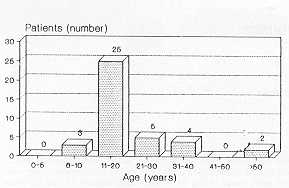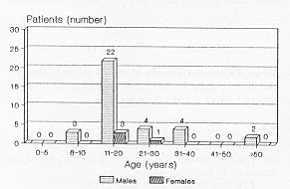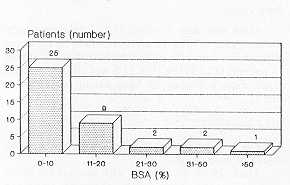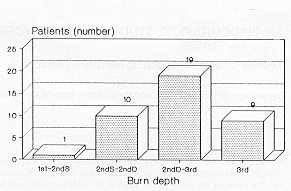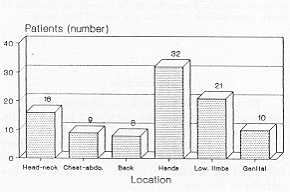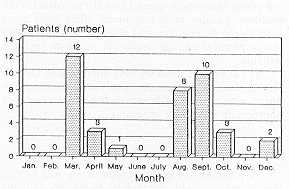| Annals of the MBC - vol. 4 - n' 3 - September 1991
AN EPIDEMIOLOGIC STUDY OF GUNPOWDER WOUNDS Tejerina C., Reig A., Codina J., Herrero J., Mirabet V. Pepartment of Plastic Surgery and Burn Centre, Hospital La Fe, Valencia,1Spain SUMMARY. A retrospective epidemiologic study was made of patients with gunpowder bums admitted to our Bum Centre between I January 1988 and I January 199 1. During this three-year period 5679 patients were treated; of these, 443 (7.8%) required hospitalization. Gunpowder was the cause of the burns in 39 cases (8.8%). Mean patient age was 21.6 years (range, 8-54); 64. 1 % were aged between I I and 20. Mean bum extent involved 13.8% of the total body surface, predominantly second-degree deep and third-degree burns being the most common association. The hands were the region most commonly affected (82%), either isolatedly or in association with wounds elsewhere. The months of March, August and September are the times of year of greatest folklore activity in our region, and lead to the highest incidence of gunpowder bums. Three patients (7.7%) died as a result of their bums. Introduction Bums continue to pose a considerable
problem in plastic surgery. Within the context of bum wounds, lesions caused by gunpowder
are of particular importance in regions such as our own, where fireworks are profusely
(and sometimes. negligently) employed in folklore activities during certain key months of
the year. Patients and methods A retrospective epiderniologic study
was carried out on patients with gunpowder burns; the patients studied were admitted to
our Burn Centre between I January 1988 and I January 1991. Results Age Mean patient age was 21.6 (range 8-54), Fig. I shows the age distribution of the 39 patients studied. 64.1% were aged 11-20, 5.1% were over 50 years of age, and no case was under age Sex Thirty-five (89.7%) patients were males, and only four (10.2%) females. Fig. 2 shows patient distribution according to both age and sex. The four women were aged 11-30.
Burn extent Mean burn area involved 13.8% of the total body surface (range 1-70%). In most cases (64. 1 %) the burns affected less than 11% of total body surface. In almost all patients (87. 1 %) less than 2 1 % was affected. Patient distribution according to bum extent is shown in Fig. 3. Burn depth Fig. 4 shows patient distribution according to the degree of burn depth.
Thus, 25.6% of patients with gunpowder
bums presented second-degree superficial wounds associated with second-degree deep burns;
23% presented isolated third-degree burns. The most common association was second-degree
deep lesions with third-degree bums (48.7%), whereas only one patient (2.5%) suffered
first-degree wounds associated with superficial second-degree burns. 25% of patients with
third-degree burns suffered tissue loss; in three cases the first and second fingers had
to be partially amputated. Burn location Burn location is indicated in Fig. 5. Season Fig. 6 shows patient distribution according to the time of year when the bums occurred. Thus, 30.7% of accidents took place in March, during the yearly Fallas folklore festivities in our region, and 46.1% in August and September, when the villages and towns surrounding metropolitan Valencia celebrate their local fiestas.
Hospital stay Mean hospital stay was 20 days (range 2-47 days). Mortality Of the 39 patients with gunpowder wounds, three (7.7%) died. These clearly corresponded to the most extensive and deepest bums affecting more vital regions. Comments In regions such as ours, where
gunpowder is so profusely employed in local festivities by non -professionals, bums and
their resulting mutilating effects pose considerable problems for plastic surgeons and for
society as a whole.
RESUME On prtsente une étude épidémiologique rétrospective des patients atteints de brfilure par explosion de poudre hospitalisés dans un centre de brfilés dans la période I janvier 1988-1 janvier 199 1. Pendant ces trois ans un nombre total de 5é79 patients ont W hospitalisés. En 39 (8,8%) de ces cas la cause des brfilures était la poudre. Udge moyen de ces patients était 21,é ans (variation 8-54 ans); é4,1% kait dgé de I I A 20 ans. La surface brfilée était en moyerme 13,8% de la surface corporelle totale; I'association la plus commune était entre les brOlures profondes du deuxiéme degré et les brélures du troisi&me degré. Les mains étaient la partic du corps la plus atteinte (82%), ou isolément ou en association avec d'autres blessures. Les mois de mars, aoét et septembre sont les périodes de I'an oé il y a la plus grande activité folklorique dans notre région, et cc sont les mois avec la plus haute fréquence de brélure par explosion de poudre. Trois patients (7,7%) sont morts A cause de leurs brCilures. BIBLIOGRAPHY
|
